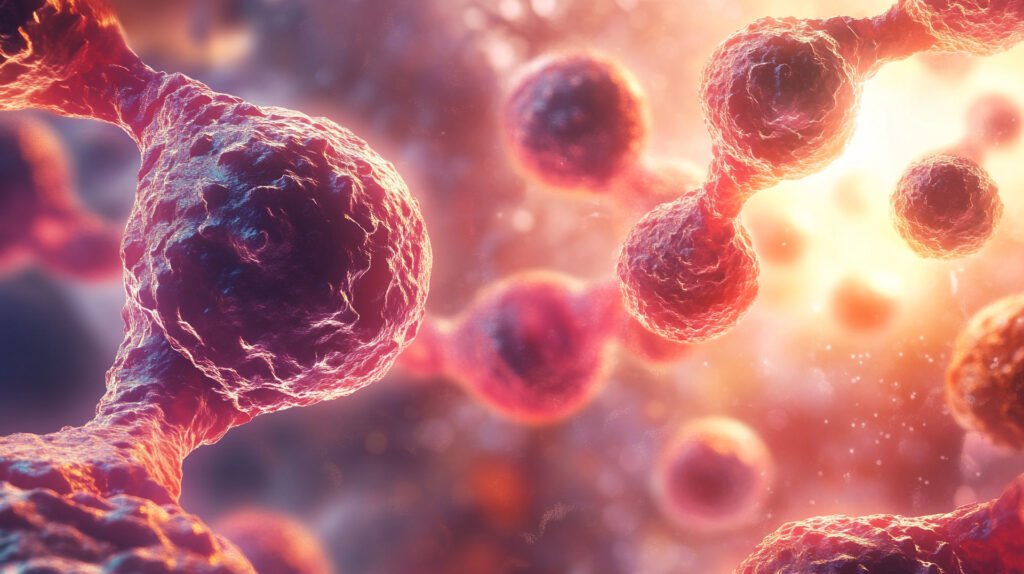Most of us associate the benefits of sunlight with vitamin D—but the health benefits of sunlight go far beyond that. Emerging research in mitochondrial health, circadian biology, and even quantum biology reveals that light is a form of information for the body. It impacts how we generate energy, regulate inflammation, repair cells, and even how we age.
We often see clients struggling with fatigue, poor sleep, metabolic issues, and accelerated ageing—despite eating well and exercising. One missing piece? Sunlight.
This article explores the hidden link between sunlight, mitochondrial function, and quantum biology, and why reconnecting with natural light might be one of the most powerful longevity interventions available.

Why Mitochondria Are the Gatekeepers of Energy and Ageing
Mitochondria are often called the “powerhouses of the cell,” but they do far more than produce energy. These tiny organelles:
- Sense and respond to light and temperature
- Regulate immune signalling and inflammation
- Coordinate cell death and renewal (apoptosis)
- Influence how fast we age at the cellular level
Their function is tightly regulated by light exposure, especially in the visible red and infrared spectrum. This is where sunlight becomes medicine.
How Sunlight Supports Mitochondrial Health
1. Red and Infrared Light Boost ATP Production
Sunlight—especially in the morning and evening—delivers near-infrared light (NIR), which penetrates deeply into the body. This light stimulates a certain enzyme (cytochrome c oxidase) in the mitochondria, enhancing ATP (the body’s energy currency) production and improving energy efficiency.
Result: More cellular energy, less oxidative stress, better repair and recovery.
2. Blue Light Synchronises Your Body Clock
Sunlight’s blue light spectrum in the morning helps entrain your circadian rhythm. This governs hormone production (like cortisol and melatonin), mitochondrial biogenesis (creation of new mitochondria), and detoxification cycles.
Result: Better sleep, improved metabolism, and healthier mitochondria.
3. Sunlight Regulates Redox Balance
Light exposure influences the redox state inside your cells. In simple terms, redox refers to the delicate balance between free radicals (which can cause damage) and antioxidants (which repair and protect cells). Mitochondria constantly monitor this balance to decide whether a cell should repair itself, grow, or trigger a natural self-destruct process if it’s too damaged.
Result: Reduced inflammation, improved resilience to stress, and slower ageing.
Quantum Biology: Light as Information, Not Just Energy
Quantum biology suggests that biological systems use subatomic processes—like electron tunnelling and photon signalling—to maintain order. In this model:
- Sunlight acts as a bio-informational signal
- Mitochondria may sense and respond to different light wavelengths to optimise energy flow
- Our bodies function as light-responsive systems, not just chemical machines
Sunlight may help align quantum coherence within cells, preserving mitochondrial integrity and DNA stability—core components of healthy ageing.
This cutting-edge view explains why artificial light and indoor living disrupt far more than sleep—they interfere with the very signalling systems that keep us alive and energised.
So, Where Does Vitamin D Fit In?
Vitamin D is a hormone, not just a nutrient. It’s synthesised when UVB rays from sunlight hit your skin, and it’s involved in:
- Immune regulation and inflammation control
- Muscle strength and bone integrity
- Brain function and mood
- Metabolic and cardiovascular health
- And many, many more
Low levels of vitamin D are linked to fatigue, low immunity, depression, insulin resistance, and shorter lifespan. But remember—vitamin D is only one part of the sunlight story.
You can take vitamin D in supplement form—but you can’t supplement red, infrared, and full-spectrum light exposure. You need real sunlight for those.
Are You Starved of Sunlight?

You may be experiencing “light deficiency” without realising it—especially if you:
- Live in the UK or Northern Europe
- Work indoors or in artificial light
- Wear sunscreen constantly or cover most of your skin
- Have darker skin (which requires longer UVB exposure)
- Rarely see the sun in the early morning or evening
This can lead to:
- Poor mitochondrial function and low energy
- Sleep issues or circadian rhythm disruption
- Low mood or cognitive fog
- Hormonal imbalances
- Vitamin D deficiency
How to Optimise Your Relationship with Sunlight
At our clinic, we help clients build a personalised light strategy to match their biology, location, and health goals. Here’s where to start:
1. See the Sunrise (Bare-Eyed)
Get 10–20 minutes of outdoor light within 30–60 minutes of waking. No sunglasses. This resets your circadian rhythm, primes mitochondrial function, and enhances melatonin release later.
2. Expose Your Skin (Safely)
Aim for daily sun exposure to at least 20–25% of your skin—especially arms and legs. Do this around solar noon for optimal UVB (vitamin D synthesis), but avoid burning.
3. Ditch Sunglasses Indoors and in the Morning
Natural light entering the eye is critical for body clock regulation. Artificial lighting doesn’t send the same biological signals.
4. Use Red/NIR Light Therapy in Winter
In darker months, or if you can’t get outside, red and near-infrared light panels can simulate some of the benefits of natural light for mitochondrial health. You can even absorb these wavelengths of light when fully clothed so no need to brave cold exposure on a harsh winter’s day in your shorts and t-shirt!
5. Test and Supplement Vitamin D When Needed
We recommend testing 25(OH)D levels at least twice per year. Most adults benefit from 1000–2000 IU/day (some even higher doses) in darker months. Through testing, we can help personalise your dose of vitamin D for your body’s needs.
Want to Measure and Optimise Your Light Biology?
We offer in-depth assessments of your mitochondrial function, circadian markers, and vitamin D status as part of our advanced longevity screening packages. If you’re experiencing:
- Chronic fatigue
- Sleep disruption
- Mood or memory issues
- Poor recovery or resilience
- Accelerated ageing signs
…it could be your mitochondria—and your light environment—calling for help.
Let’s Optimise Your Light, Energy, and Longevity
Human biology (and indeed of every organism on the planet!) evolved basking in the natural light cycles of the sun and the further we take ourselves from that, the further we usually veer from optimal health. At Agami Health, we take a 360° view of your health and environment—blending principles from functional medicine, quantum biology, and longevity science. We help you build a life that aligns with your evolutionary blueprint.
References
- Kift R, Webb AR. Getting Enough UVB from Sunlight to Synthesize Vitamin D: Not So Simple for Everyone. Nutrients. 2024. PMC11124381
- Hamblin MR. Mechanisms of red and near-infrared light therapy. Photochem Photobiol Sci. 2016.
- Cifra M, Pospíšil P. Ultra-weak photon emission from biological samples: quantum and coherence aspects. J Photochem Photobiol B. 2014.
